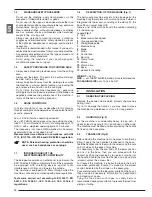
11
EN
2.4
POSITION/WORK STATION (Fig.3)
Place the machine on a sufficiently flat workbench so that
the machine has the better possible stability.
In respect of ergonomic criteria during cutting operations,
the workbench must be positioned at such a height that the
clamp level is between 90 and 95 cm from the ground
(see
fig. 3)
.
ATTENTION: Make sure that the machine is placed
in a working area with suitable environmental
conditions and lighting. The general conditions
of the working environment are of fundamental
importance for accident prevention.
2.5
ELECTRICAL CONNECTIONS
Check that the mains to which the machine is connected is
earthed in accordance with current safety regulations and
that the power point is in good condition.
Remember that there should be a magnetothermic
protective device fitted upstream of the mains to protect
all the conductors from short circuits and overloads.
This protective device should be selected according to the
electrical features of the machine listed below:
Nominal voltage .............................................. 230 Volt ~
Nominal frequency ....................................... 50/60 Hertz
Max programmed absorbed value ................... 2000 Watt
Nominal input power ........................................ 1200 Watt
Power factor ............................................................. 0,96
Nominal speed ................................... 11.000-23.000 rpm
Insulation ........................................................... Classe B
Type of service ............................. intermittent S4-60 %
In case of power failure in mains, while you wait for
power to be restored there is no danger hazard may
arise: in fact, the electronic governor O (Fig. 7) is also
equipped with a reset function which prevents the
machine from restarting automatically.
The motor of your sawing machine is equipped with a
protective heat circuit breaker which interrupts the
power supply when the temperature of the coils rises
too high.
When the power supply is interrupted, wait for normal
reset.
3
ADJUSTING (Fig. 4-5-6-7-8)
3.1
TENSION OF THE BLADE (Fig.4)
ATTENTION: The machine is fitted with a blade-
tightening device that limits tension
automatically.
Turn handwheel
B
clockwise until the clutch engages
3.2
BAR STOP (Fig.5)
Use the bar stop supplied if you have to do several cuts
on pieces of the same length.
In this way you do not have to repeat the same
measurement each time.
Screw rod
E
into the hole of the base and fasten it with nut
F.
Slacken the handwheel
G
and place the stop
L
at the
correct distance from the blade. Tighten handwheel
G
again.
3.3
CUTTING ANGLE (Fig.6)
To performe a cut at 45, slacken the two knobs
M
and
rotate the body to the left until it rest on stop
N
, whose
position was calibrated during the final inspection.
For all the other intermediate angles, match the indicator
of the swivel supporto with the respective position on the
plate
O.
3.4
CUTTING SPEED (Fig.7)
Your sawing machine is equipped with CESC (Constant
Electronic Speed Control), which allows gradual and
continuous variation of the cutting speed, adapting it to the
type and dimension of the material to be cut (see CUTTING
TABLE ).
To select the most suitable speed, use the speed control
knob
O
to increase or decrease the speed as you require.
3.5
SLIDING BLADE GUIDE (Fig. 8)
The sliding blades guide
P
with integrated protection fitted
on your sawing machine is used to perform the cut while
guiding the necessary part of the blade and fully protecting
the part not used in the cutting process.
Slacken the knobs
Q
and slide the blades guide
P
so as to
move it closer to or further from the part to be cut, as
shown in the figure.
ATTENTION: If this adjustment is not done, the
part of the blade not used in the cutting process
will be exposed and this will create an extra
risk of contact, besides altering the quality of
the cut.
3.6
BEARINGS BLADE GUIDE (Fig.9)
The blade-guide on the outside of the sawing machine are
eccentric and adjustable so as to simplify blade replacement
and to keep it guided as its best.
They must always touch the blade slightly, so that they
rotate when the blade passes, but must not be completly
locked.
In order to approach or remove the eccentric blade-guide,
gently turn the head of the screws
R
using a 10 mm.
wrenches key.
4
USE
4.1
RUNNING IN THE BLADE
ATTENTION: If the correct running in procedure
is not performed, the bladès cutting precision
may be irreparably compromised.
To obtain the best performance, the bi-metal blades fitted
on your sawing machine must be run in for a short period.
For this reason the first two or three cuts should be done
where possible on a solid piece Ø 40-50 mm, using a very
slight pressure on the blade, and gradually increasing
pressure in subsequent cuts.
To gauge the correct pressure in normal operating conditions
defined by this manual (see cutting table), consider for
example that the first cut on solid steel (eg. C40) Ø 50 mm
should be done in about 4 minutes.



























